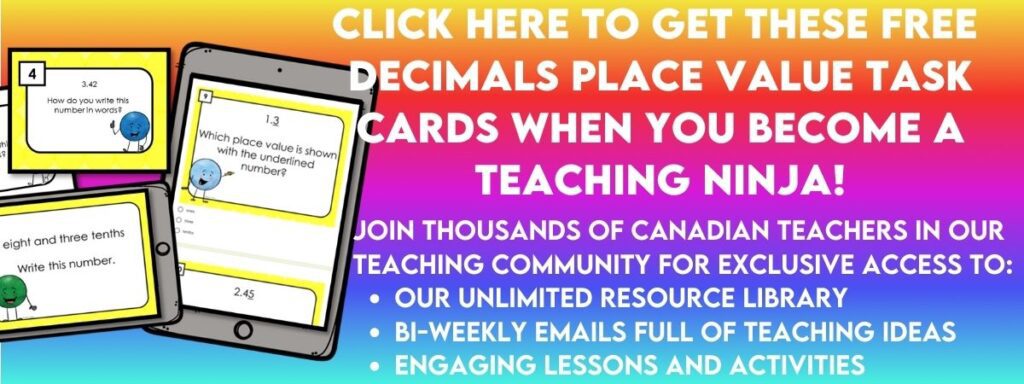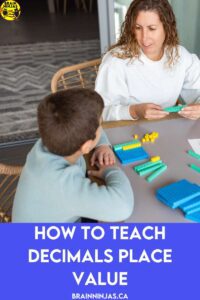
For some students, place value comes second nature, but for others, it can be very challenging. Once you add decimals into the mix, it can become downright confusing. Come check out some of the strategies we use to help students master decimals place value.
Start With Base 10
We head back to basics by using Base 10 blocks. Use a tens bar to talk about tenths. Draw bars and shade different amounts of squares in each. As students read them, explain that when talking about whole numbers, each square represents one. So, if four squares are coloured, we are talking about the number four. Decimals are parts of whole numbers. If four squares are coloured we are saying four pieces out of ten. It sounds like a fraction, so we say four tenths.
For some students, hearing it sound like a fraction makes it click. Others need more practice, so colour and count more bars. Dig out ten ones in your Base 10 set and have students practice.
Once they have tenths down, try doing the same activity for hundredths. Use a hundreds square, shade thirty-four. Explain that if it were a whole number, the amount shaded would be thirty-four. If this represents decimals place value, then it is thirty-four hundredths.
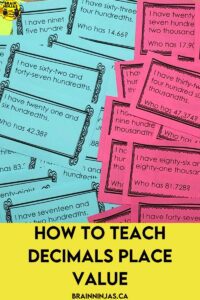
Practice saying decimals correctly
Most of the challenge with understanding decimals place value comes from saying the numbers correctly. This takes practice, but if students master it, it helps when they need to convert decimals to fractions or vice versa.
One way we help students master decimals place value is by practicing saying them. We created a game that encourages students to read and say decimals correctly. Find our Saying Decimals Game in our TpT Store ($USD) or our BN Shop ($CAN). It includes tenths, hundredths, and thousands in three different versions of the game, making it easy to differentiate.
Using a Decimals Place Value Chart
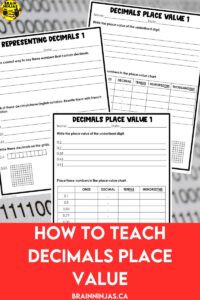
Draw a standard place value chart with ones, tens, hundreds, and thousands (or more if your students know more). Practice reading numbers in the chart. Place a column to the right of the ones column and put a decimal point in it. Explain that all whole numbers actually have a decimal point. Technically, it can be followed by an infinite number of zeros, but to save time, people leave out the decimal point, and it is understood that it’s there.
This is also a great time to explain that while we use a period to represent the decimal point, other places use a comma. It’s important to know which symbols to use so if students encounter them, they can avoid confusion.
Explain that the decimal point is pronounced differently depending on the purpose.
In money, we say five dollars and thirty-two cents for $5.32. If we were just saying the digits, we might say five point three two. When saying a decimal, it’s important to say the number correctly. The whole number before the decimal point is said as usual. The decimal point is said as “and,” while the numbers after the decimal are said as one complete number followed by the name of the last place value column. So 5.32 is said as five and thirty-two hundredths.
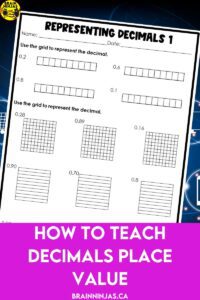
Explicitly Teach Decimals Place Value
Once we’ve introduced decimals, we teach the names of the columns and make a reference page in our math book. Our interactive math units include everything you need to teach, review, practice and assess decimals place value. Best of all, you don’t need to plan anything because we’ve already done it for you.
We have interactive math units that include decimals with different levels of difficulty depending on the grade levels. Each of the units can also be found in a year-long resource.
- Decimals and Fractions Interactive Math Unit Grade 4 in our TpT Store ($USD) and BN Shop ($CAN).
- Decimals and Fractions Interactive Math Unit Grade 4/5 in our TpT Store ($USD) and BN Shop ($CAN). This is designed for classrooms with combined grade levels.
- Decimals and Fractions Interactive Math Unit Grade 5 in our TpT Store ($USD) and BN Shop ($CAN).
- Decimals, Fractions, Ratios and Percent Interactive Math Unit Grade 5/6 in our TpT Store ($USD) and BN Shop ($CAN). This is designed for classrooms with combined grade levels.
- Decimals, Fractions, Ratios and Percent Interactive Math Unit Grade 6 in our TpT Store ($USD) and BN Shop ($CAN).
Create an Anchor Chart
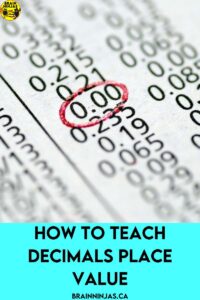
Have your students create a decimals place value chart that names each of the columns. Hang it where it is visual for the whole unit. We leave ours up all year. Having students help make the poster and choose where to hang it will help them remember to use it.
Practice, Practice, Practice
It is worth the extra time to practice decimals place value as it will help with all the operations moving forward.
We practice using worksheets, but we use them in different ways. Our post Math Worksheet Games Your Students Will Love is full of ideas to help.
We also have some worksheet sets that your students may find helpful.
- Representing Decimals to Hundredths in our TpT Store ($USD) and BN Shop ($CAN).
- Representing Decimals to Thousandths in our TpT Store ($USD) and BN Shop ($CAN).
- Comparing and Ordering Decimals to Hundredths in our TpT Store ($USD) and BN Shop ($CAN).
- Comparing Decimals to Thousandths in our TpT Store ($USD) and BN Shop ($CAN).
We also use task cards. We’ll send you this free set of decimals place value task cards when you sign up for our email list. If you’re already on the list, you can find it in our Resource Library.
If you are looking for more ways to use task cards in your math class, we have this post: The Trouble With Task Cards and How to Fix It.
Do you teach math in Canada?
We have other math posts that you might find useful:
- How to Help Your Students Master Decimal Operations
- How to Teach Rounding Numbers
- How to Change Math With Interactive Notebooks
How do you teach decimals place value? We’d love to hear about it in the comments below.

